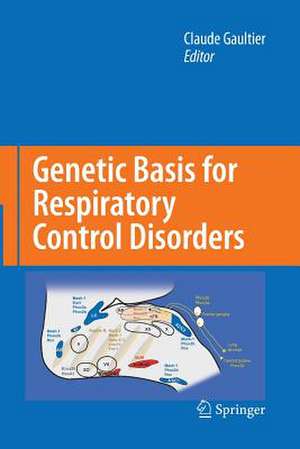Genetic Basis for Respiratory Control Disorders
Editat de Claude Gaultieren Limba Engleză Paperback – 17 sep 2014
| Toate formatele și edițiile | Preț | Express |
|---|---|---|
| Paperback (1) | 947.50 lei 43-57 zile | |
| Springer Us – 17 sep 2014 | 947.50 lei 43-57 zile | |
| Hardback (1) | 814.21 lei 38-44 zile | |
| Springer Us – 17 oct 2007 | 814.21 lei 38-44 zile |
Preț: 947.50 lei
Preț vechi: 1155.48 lei
-18% Nou
Puncte Express: 1421
Preț estimativ în valută:
181.30€ • 189.80$ • 150.02£
181.30€ • 189.80$ • 150.02£
Carte tipărită la comandă
Livrare economică 07-21 aprilie
Preluare comenzi: 021 569.72.76
Specificații
ISBN-13: 9781489988928
ISBN-10: 1489988920
Pagini: 360
Ilustrații: XXXI, 324 p.
Dimensiuni: 155 x 235 x 19 mm
Greutate: 0.5 kg
Ediția:2008
Editura: Springer Us
Colecția Springer
Locul publicării:New York, NY, United States
ISBN-10: 1489988920
Pagini: 360
Ilustrații: XXXI, 324 p.
Dimensiuni: 155 x 235 x 19 mm
Greutate: 0.5 kg
Ediția:2008
Editura: Springer Us
Colecția Springer
Locul publicării:New York, NY, United States
Public țintă
ResearchCuprins
Respiratory control disorders: from genes to patients and back.- Hereditary aspects of respiratory control in health and disease in humans.- Congenital central hypoventilation syndrome: from patients to gene discovery.- Phox2b and the homeostatic brain.- Congenital central hypoventilation syndrome: from patients to gene discovery.- Structural and functional brain abnormalities in congenital central hypoventilation syndrome.- In vitro studies of Phox2b gene mutations in congenital central hypoventilation syndrome.- Sudden infant death syndrome: study of genes pertinent to cardiorespiratory and autonomic regulation.- Genetic basis for obstructive sleep apnea syndrome: what role for variation in respiratory control?- Apnea and irregular breathing in animal models: a physiogenomic approach.- Genetic determinants of respiratory phenotype in mice.- Genes and development of respiratory rhythm generation.- Transcription factor control of central respiratory neuron development.- Lessons from mutant newborn mice with respiratory control deficits.- Tentative mouse model for the congenital central hypoventilation syndrome: heterozygous Phox2b mutant newborn mice.- Respiratory control abnormalities in necdin-deficient mice: implications for the pathogenesis of Prader-Willi syndrome.- Possible role of bioaminergic systems in respiratory disorders of Rett syndrome.- Respiratory plasticity following intermittent hypoxia: a guide for novel therapeutic approaches to ventilatory control disorders.
Textul de pe ultima copertă
Genetic Basis for Respiratory Control Disorders provides an overview of the recent knowledge of the genetic factors underlying respiratory control disorders, an emerging field in respiratory biology. Identifying genes involved in respiratory control is crucial for understanding human diseases characterized by abnormal respiratory control, such as Prader-Willi syndrome, Rett syndrome, congenital central hypoventilation syndrome (CCHS), obstructive sleep apnea syndrome (OSAS), central sleep apnea syndrome, apneas of prematurity and sudden infant death syndrome (SIDS). Furthermore, genetic factors play a key role in respiratory control adaptation in health and disease, most notably in the respiratory response to intermittent hypoxia.
The objective of the book is to supply state-of-the-art contributions about all aspects of respiratory control genetics, from the molecular to the system level. The book aims to review the full spectrum of available knowledge, which starts with early physiological studies in health and disease in humans and studies in rodents that suggested a hereditary component to respiratory control. The spectrum extends to recent work elucidating crucial molecular aspects of respiratory control development, from early embryonic specifications in the neural tube to the function of respiratory rhythm generators.
Developmental programs and gene expression profiles of different neuron types in the respiratory-control neuronal network have been characterized, together with their control by specific sets of transcription factors. In mice, targeted inactivation of several transcription factors disrupts the development of specific respiratory-neuron groups and causes abnormal respiratory phenotypes. These effects are described in detail in the book, with . a special attention to was given to the role of the transcription factor Phox2b. The developmental and respiratory phenotypes in newborn mice with Phox2b gene deletion and in vitro investigations of human mutated PHOX2B proteins have shed light on the pathogenesis of CCHS. Respiratory control abnormalities in necdin-null mice and in mice lacking Mecp2 gene have provided new insights into the developmental origins of the respiratory disorders seen in Prader-Willi and Rett syndromes, respectively. Current genetic data in complex and multi-factorial respiratory disorders, including SIDS and OSAS, are described.
Genetic Basis for Respiratory Control Disorders emphasizes the potent synergy between human studies and mouse models of genetic disorders underlying respiratory control anomalies. The overview of current research presented in this book opens up the field to the development of new therapeutic strategies, especially in newborns and infants, who are the primary target of respiratory control disorders. This book is addressed to pediatricians, neonatologists, pulmonologists, respiratory physiologists as well as geneticists.
The objective of the book is to supply state-of-the-art contributions about all aspects of respiratory control genetics, from the molecular to the system level. The book aims to review the full spectrum of available knowledge, which starts with early physiological studies in health and disease in humans and studies in rodents that suggested a hereditary component to respiratory control. The spectrum extends to recent work elucidating crucial molecular aspects of respiratory control development, from early embryonic specifications in the neural tube to the function of respiratory rhythm generators.
Developmental programs and gene expression profiles of different neuron types in the respiratory-control neuronal network have been characterized, together with their control by specific sets of transcription factors. In mice, targeted inactivation of several transcription factors disrupts the development of specific respiratory-neuron groups and causes abnormal respiratory phenotypes. These effects are described in detail in the book, with . a special attention to was given to the role of the transcription factor Phox2b. The developmental and respiratory phenotypes in newborn mice with Phox2b gene deletion and in vitro investigations of human mutated PHOX2B proteins have shed light on the pathogenesis of CCHS. Respiratory control abnormalities in necdin-null mice and in mice lacking Mecp2 gene have provided new insights into the developmental origins of the respiratory disorders seen in Prader-Willi and Rett syndromes, respectively. Current genetic data in complex and multi-factorial respiratory disorders, including SIDS and OSAS, are described.
Genetic Basis for Respiratory Control Disorders emphasizes the potent synergy between human studies and mouse models of genetic disorders underlying respiratory control anomalies. The overview of current research presented in this book opens up the field to the development of new therapeutic strategies, especially in newborns and infants, who are the primary target of respiratory control disorders. This book is addressed to pediatricians, neonatologists, pulmonologists, respiratory physiologists as well as geneticists.
Caracteristici
First to provide an overview of recent advances in the genetics of respiratory control in health and disease
Includes supplementary material: sn.pub/extras
Includes supplementary material: sn.pub/extras
















